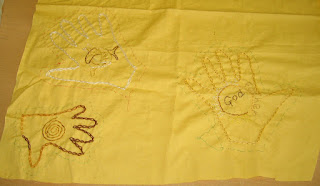Out of Your Comfort Zone was June's challenge, and defined as,
"Create a garment from a time period you haven’t done before, or that uses a new skill or technique that you’ve never tried before."
I had a plan for this challenge, but unfortunately it was so far out of my comfort zone that I never even mustered the courage to start! So it languished, with the vague idea that I'd tackle it in December. In the meantime, my friend Suzanne Iuppa asked me to make a medieval-inspired stage costume for her performances at Sanctum, a 24-day arts event taking place in the remains of a 12th-century Knights Templar church in Bristol.
 |
| The temporary Sanctum building. Photograph by Max McClure, taken from the Guardian website |
Medieval is definitely out of my comfort zone (as is making clothes for other people!) as I've never made anything like that before. Suzanne wanted a dress and jacket/doublet, and had taken her inspiration from two films about Joan of Arc.
 |
| The Passion of Joan of Arc, Carl Dreyer, 1928 |
 |
| The Trial of Joan of Arc, Robert Bresson, 1962 |
All the readily available commercial patterns for 'medieval' dresses involved princess line bodices and waist seams. I may not have known much about medieval costume when I started this project, but I did know that it doesn't involve either of those things, so I decided to draft my own pattern. Fortunately I had Margaret Scott's Medieval Dress and Fashion for inspiration, and for practical advice Sarah Thursfield's The Medieval’s Tailor’s Assistant, plus The Dreamstress' tutorial on draping a fourteenth century dress.
Unfortunately what I didn't have was Suzanne to drape the dress on, so I had to improvise. I drafted a basic bodice block from Suzanne's measurements, and then manipulated the darts to create a block with a curved centre front seam. I made the sleeves longer and narrower, but stupidly didn't think to redraft them to move the seam from underarm to a more period-accurate centre back - gah!
This didn't really matter, because the end result was never going to be remotely historically accurate; its requirements as a stage costume for a solo performer in a cold environment (most of Suzanne's performances were taking place at dawn) had to take precedence. Thus the dress has a zip fasten, and both it and the jacket are made from fleece.
The mock-up of the dress was made in an alarming bright yellow, because this was half price in the fabric shop. After I'd reassured Suzanne that the finished article would not be this colour, she put the dress on inside out, and I pinned out the excess fabric, and marked the neckline.
 |
| Altering the back seam |
 |
| The sleeve, with the new seam pinned out |
The doublet pattern was drafted from the dress, with extra ease added. Probably a bit too much ease, but it added to the impression that this was a man's garment. (Well, that's my excuse.) We decided to reinforce this idea by setting the buttons and buttonholes on the male sides, rather than the female. I added the small collar and the rolls on the sleeve heads, in line with the costume from the 1928 film.
 |
| Bad photograph (sorry) of the completed doublet |
 |
| Suzanne wearing the doublet and dress at Sanctum |
 |
| The doublet open, showing the dress |
I added a lining to the jacket, as I feared that a fleece jacket and a fleece dress might stick together otherwise. Most of the lining was sewn by hand, as a group of us went down to Somerset for a long weekend shortly before Suzanne's performance. It's been a while since I've had the pleasure of spending a evening chatting with friends, drinking wine and sewing - it was lovely! One day we went to Wells, and Suzanne took the dress with her, in the hope of a photo opportunity. We managed to take some pictures in the cathedral, on the way up to the Chapter House. This is my favourite part of the building; I love the way one set of steps curves out from the main staircase. If it looks familiar, it may be because a couple of scenes in Wolf Hall were filmed here.
 |
| Wells Cathedral, the Chapter House steps |
 |
| Suzanne on the steps |
 |
| Looking down the staircase |
The small print:
The Challenge: Out of Your Comfort Zone
Fabric: Fleece and lining fabric
Pattern: My own
Year: 1928 and 1962 do 1431
Notions: Buttons for doublet, zip for dress
How historically accurate is it? Far and away the least historically accurate item I’ve ever made in three years of the Historical Sew Fortnightly/Monthly, about 5%
Hours to complete: As ever, forgot to count
First worn: 5 November at Sanctum, Temple Church, Bristol
Total cost: £39.50















































